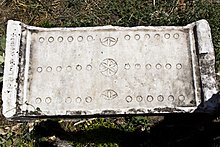Ludus duodecim scriptorum


Ludus duodecim scriptorum, or XII scripta, was a board game popular during the time of the Roman Empire. The name translates as "game of twelve markings", probably referring to the three rows of 12 markings each found on most surviving boards. The game tabula is thought to be a descendant of this game, and both are tables games as is modern backgammon.[1]
It has been speculated that XII scripta is related to the Egyptian game senet.[2] A factor casting doubt on this link is that the latest known classical senet board is over half of a millennium older than the earliest known XII scripta board.
Very little information about specific gameplay has survived. The game was played using three cubic dice, and each player had 15 pieces. A possible "beginners' board", having spaces marked with letters, has suggested a possible path for the movement of pieces.[1]
The earliest known mention of the game is in Ovid's Ars Amatoria (The Art of Love) (written between 1 BC and 8 AD). An ancient example of the game was excavated at the archaeological site of Kibyra in southern Turkey.[3]
References
[edit]- ^ a b Austin, Roland G. "Roman Board Games. I", Greece & Rome 4:10, October 1934. pp. 24-34.
- ^ Hübener, Hardy. "Tabular History of Backgammon". Hardy's Backgammon Pages. Retrieved 2007-01-09.
Ludus Duodecim Scriptorum seems to have developed from the game Senet.
- ^ "Ancient game found in Roman era city". Hürriyet Daily News. Retrieved Aug 1, 2020.
External links
[edit]- Duodecim scipta: Latin game rules by Caelestis Eichenseer 1985
- — The Lines of the Twelve Philosophers, which may be related to XII scripta
